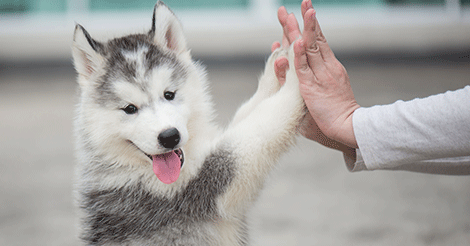The Best Puppy Training Tools You Need to Ensure Success
The Best Puppy Training Tools You Need to Ensure Success
Blog Article
Top Pup Educating Strategies to Ensure a Mannerly Pet Dog
Effective pup training is crucial for cultivating a mannerly friend, and various techniques can substantially influence a canine's advancement. As we check out these techniques additionally, it ends up being clear that the success of puppy training hinges on a combination of approaches that can change your animal's habits in impressive methods.
Positive Reinforcement Techniques
Using favorable reinforcement methods is crucial for effective pup training, as it encourages preferred actions via rewards rather than penalty. This method profits from the natural learning procedures of dogs, strengthening etiquette by giving tangible and prompt benefits, such as deals with, appreciation, or playtime. By associating favorable outcomes with specific activities, pups are more probable to repeat those actions in the future.
Efficient favorable support involves timing and uniformity. Benefits must be provided immediately after the wanted habits strikes produce a clear link in the puppy's mind. Additionally, differing the types of benefits can preserve a young puppy's rate of interest and motivation throughout the training procedure. Some puppies may respond far better to spoken praise while others may prefer a favored toy or treat.

Uniformity in Training Commands
Keeping uniformity in training commands is essential for enhancing the lessons found out through favorable support techniques. Canines thrive on regular and predictability, so utilizing the exact same verbal commands and hand signals for certain habits is necessary. This harmony helps young puppies understand what is expected of them, minimizing confusion and aggravation for both the trainer and the family pet.

Timing additionally plays a significant duty in uniformity. Commands must be provided promptly during training sessions and complied with right away by favorable reinforcement, such as deals with or appreciation. This prompt action assists strengthen the association between the command and the preferred actions.
Incorporating uniformity right into training sessions will certainly produce a stable understanding atmosphere, promoting quicker mastery of commands. Ultimately, a well-structured method cultivates a strong bond between the pup and its proprietor, bring about an extra obedient and well-behaved family pet.
Socializing With Other Family Pets
Socialization with various other family pets is essential for a pup's advancement, as it assists them find out appropriate actions and communication skills in varied social contexts. Early interactions with different animals can substantially affect a young puppy's personality and versatility in numerous circumstances. When puppies are exposed to a selection of pets, they become a lot more positive and much less afraid, which can stop possible behavioral issues later on in life.

Moreover, observing body language during interactions is crucial. Show your pup to identify signals from other pets, such as indications of playfulness or pain, promoting common regard and understanding. Routine socialization not just improves your puppy's social skills yet additionally adds to their overall well-being, developing a more unified living setting. Finally, prioritizing communications with other animals will yield a socially adept and all-round dog.
Pet Crate Training Conveniences
Identifying the numerous benefits of pet crate training can substantially improve both the puppy's and proprietor's experience. Crate training offers a risk-free and safe setting for pups, ensuring they really feel shielded when laid off. This complacency can significantly lower stress and anxiety and anxiety levels for both the owner and the pet.
In addition, crates act as a beneficial house-breaking device. Puppies naturally avoid dirtying their resting area, thereby urging them to hold their bladder until they are let outside. This impulse can speed up the house-breaking procedure, fostering great practices early.
Crate training also aids in handling a pup's habits when not being watched. By giving a designated space, owners can protect against devastating behaviors, such as eating on furnishings or getting involved in harmful compounds. In addition, crates can Full Report be beneficial during traveling, providing a familiar room that can help calm a young puppy in new atmospheres.
Lastly, establishing a cage routine motivates independence, enabling pups to learn exactly how to be alone without worry. Overall, dog crate training is a reliable technique for promoting peace, discipline, and security, leading to a well-adjusted, well-behaved animal.
Leash Training Fundamentals
Leash training is an essential facet of liable pet ownership that guarantees a enjoyable and safe walking experience for both the pup and its owner. Proper leash training starts early, preferably during the puppy's socializing period. When out in public., this training helps develop great routines and promotes favorable actions.
To start, select a comfortable collar or harness that fits your puppy well. Connect a strong chain, guaranteeing it is not too long, as this can bring about pulling and erratic behavior. Begin in a silent environment to lessen diversions and slowly present your puppy to brand-new surroundings.
Use positive reinforcement techniques, such as treats and appreciation, to motivate your puppy to stroll beside you. If your puppy pulls, stop strolling and wait for them to return to your side before proceeding.
In addition, integrate brief training sessions with enjoyable disturbances to construct your young puppy's emphasis. With devotion and persistence, chain training will lead to a hospitable friend, making strolls pleasurable for both the young puppy and the owner.
Verdict
In verdict, utilizing effective puppy training techniques is important for creating a well-behaved pet. On the whole, these techniques jointly advertise an unified partnership in between pups and their proprietors.
As we explore these techniques better, it comes to be clear that the success of puppy training check this site out hinges on a combination of methods that can transform your family pet's behavior in remarkable means.
Using positive reinforcement methods is important for efficient puppy training, as it urges desired habits with benefits instead than penalty.Crate training likewise assists in handling a young puppy's habits when unsupervised.Leash training is a fundamental element of liable animal ownership that makes certain a secure and satisfying strolling experience for both the pup and its owner.In verdict, utilizing reliable young puppy training techniques is crucial for establishing a well-behaved family pet.
Report this page